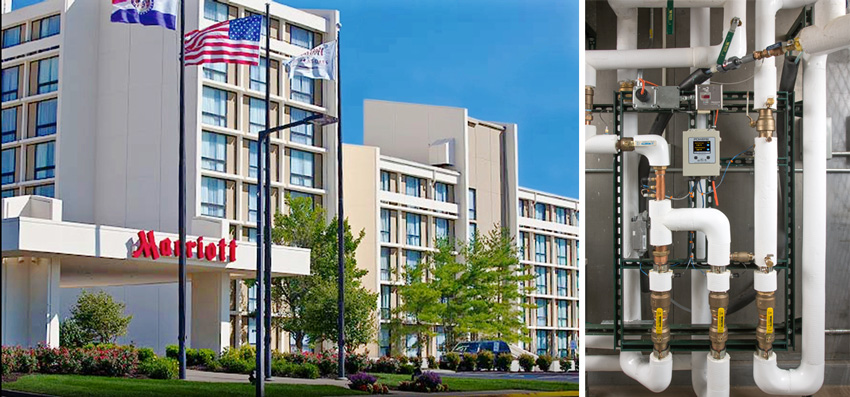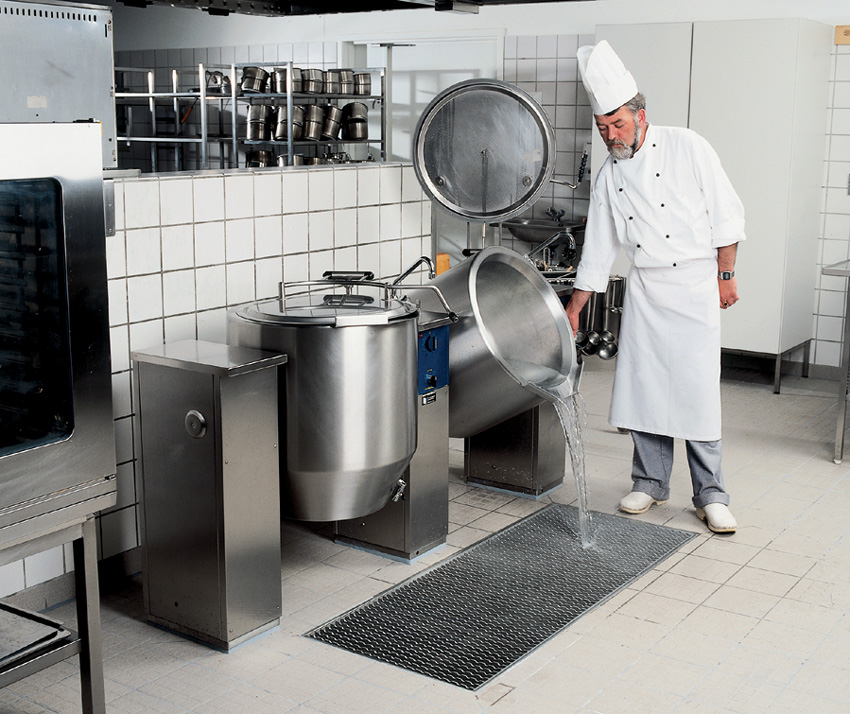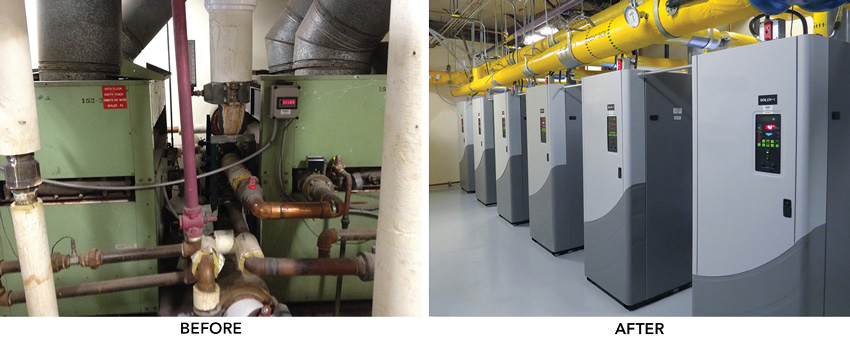Water Safety and Efficiency in Hospitality Buildings
Back-of-house water systems can impact guest satisfaction throughout a facility
![]() Continuing Education
Continuing Education
Use the following learning objectives to focus your study while reading this month’s Continuing Education article.
Learning Objectives - After reading this article, you will be able to:
- Identify the unique and specific water-related demands of hospitality facilities when it comes to the health, safety and expectations of guests and related operational challenges.
- Investigate specific safety issues related to water systems in hospitality settings such as protection against scalding, contaminants, Legionnaire’s Disease, slips and falls and other potential threats.
- Assess the solutions available for different parts of a total water supply and drainage system to assure water quality, safety, and efficient water use.
- Describe the lessons learned in some specific hospitality buildings as described in case studies describing design, construction and operation to ensure guest safety and satisfaction and best use of water resources.
Hospitality facilities come in a variety of types and styles. At one end of the spectrum are full-service hotels which are noted for providing a very upscale, even luxurious experience for their guests. These properties often have multiple food service options, including banquet facilities and expansive pool areas that offer food and beverage as well as on-site laundry services and a full range of all other amenities and services. At the other end are limited-service facilities that are geared to travelers seeking economy. While these locations may not offer a restaurant as part of the property, they do increasingly offer other basic amenities such as modest fitness rooms, self-serve guest laundry, swimming pools, and small meeting rooms. In between these two ends of hospitality types are a hybrid style known as select service hotels. This type has been the fastest growing segment of hospitality construction believed to make up about 80 percent of new hotel openings in recent years. These properties typically have some limited food service capabilities and other selected service and amenity offerings. They tend to keep operating costs in check by offering those services and amenities in moderation.
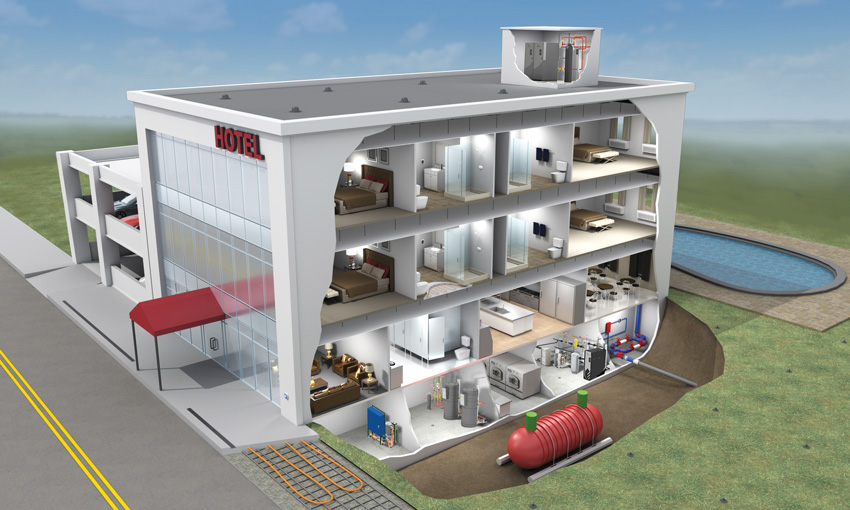
All images courtesy of Watts Water Technologies
Hospitality facilities come in different types and sizes, but all of them have the need for large quantities of high-quality water for different uses.
Regardless of the type of hospitality property, one thing that all of them have in common is that they are all typically very large consumers of water, both heated and not. Guests and patrons of any of these establishments have come to expect the fundamental service of hot and cold water to be abundantly available and controllable just as it is in their own homes, if not more so. Of course with hundreds, even thousands of guest rooms in a single facility all requiring water, often all around the same times of day, some design attention is needed to reliably provide that water. In addition, the kitchens, laundries, pools, spas, and even hydronic mechanical systems all need water that is reliable, potable, and free from contaminants. This course will look at some of the most common issues and solutions related to water systems in hospitality settings recognizing that the options are now more advanced and more likely to achieve greater guest satisfaction—if they are designed and specified properly.
Water Demand in Hospitality Facilities
Water demand clearly affects many different locations in a typical hospitality facility. Guestrooms and public restrooms all have toilets that require many gallons per day of cold water plus sinks with the requisite need for both hot and cold water. Showers and bathtubs in guestrooms are large daily users of hot and cold water with the operational challenge of demand time, since most showers are used first thing in the morning as people awake or late at night before guests go to bed. Spas and pools will also typically have showers and restrooms which may or may not have the same time-related hot and cold water demands, but the need is likely predictable at most properties.
Beyond the direct consumption of water by guests, there are plenty of areas that require water for other reasons. Kitchens and laundries use both cold and hot water but require higher temperatures for washing than for bathrooms. That can mean a different method of providing the higher temperature than may be used for the more typical temperatures. Dining rooms need an abundance of potable drinking water and ice, which needs to be particularly sensitive to the taste of the water. Then there are some utilitarian demands for water such as mechanical equipment, pools, landscaping, heated snow melt, and general cleaning. As a user of hospitality facilities, it is easy to take all of these water uses for granted. As design professionals, we can’t afford to do that, but instead need to be attentive to the details of providing appropriate hot and potable water in all of these situations.
Beyond abundance and temperature, water quality is important too. Most hospitality facilities are connected to some type of public water source, which is likely treated and tested at a central water plant. Of course, water quality can vary between locations such that even though it is considered safe drinking water per federal standards, it may contain legally acceptable levels of contaminants or treatment chemicals, such as chlorine, that can affect the color, taste, and odor. Further, as the water passes through the distribution lines of the locality on its way to the building, it may pick up other contaminants such that it doesn’t have the same qualities as when it left the water plant.
Due to the sheer volume of water used in hospitality facilities, there are multiple reasons that water quality is important. First, it needs to be clear, odor free, and contaminant free for human consumption, including drinking, making ice, and as an ingredient in many food/ cooking recipes. Contaminants of concern are not only physical as in sediment or chemicals, but they are also biological as in unwanted bacteria that can enter the water. Secondly, the degree of “hardness” of the water needs to be addressed since hard water will introduce scale or minerals into the water that can discolor or damage plumbing fixtures and appliances. For all of these reasons, the plumbing system and components for water in a hospitality setting need to be designed to assure that the quality of the water is addressed, controlled, and monitored. To achieve that, it is often best for design professionals to work together with system suppliers during both design and construction to focus on solutions that incorporate overall best practices, not just focus on plumbing products.
Guest Safety and Water
Beyond customer satisfaction and comfort, design professionals and hospitality facility staff share in the responsibility of providing safe environments for their guests. Public safety is a common concern in a variety of situations, but there are some very specific ways that water is a player in hospitality settings. While operations and management are important in this regard, so is the fundamental design of water systems to address a few key areas.
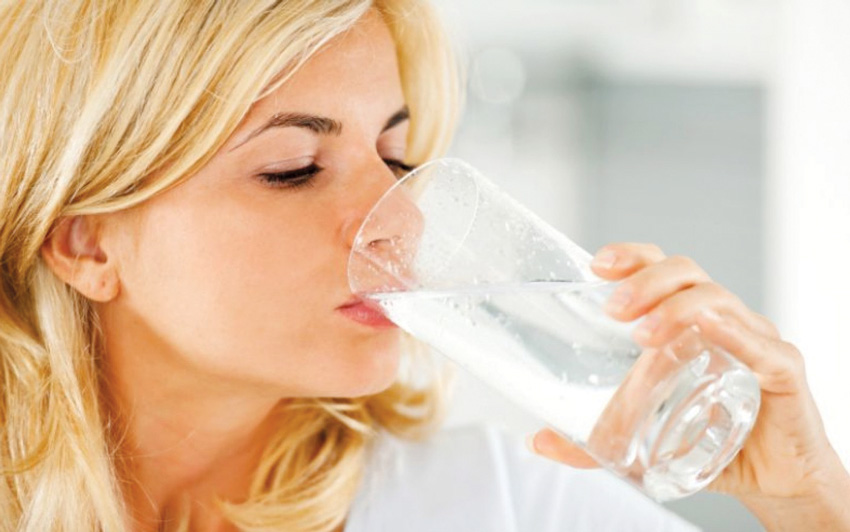
Abundant, pure drinking water is typically needed for food service and beverage operations in hospitality settings.
Protection Against Scalding
The point where human skin meets heated water is a common safety concern since it is well known that people start to experience pain when water is at or above 106 degrees Fahrenheit. Scalding and burns can occur when the temperature is above that, with severe burns possible in only a matter of 2–3 seconds at 140 degrees Fahrenheit. It is significant, therefore, that a survey conducted at major hotel chains across the United States has revealed a vast majority of hotel sinks, bath, and shower fixtures deliver water at scalding temperatures. Of the first 100 rooms surveyed, more than 91 percent delivered maximum hot water temperatures for showers in excess of 115 degrees Fahrenheit (46.1 degrees Celsius), while 78 percent provided water in excess of 120 degrees Fahrenheit (48.9 degrees Celsius). Clearly, there is a need to address limits of hot water temperature as well as control.
Protection Against Legionnaires’ Disease
Some diseases are based on bacteria that grows in water. When the water/bacteria mix is released into the air as vapor or moisture (as in showers, fountains, and some HVAC equipment), it can be inhaled and infect a person with the disease. The most well-known example of this that has received a lot of attention in hospitality facilities is Legionnaires’ disease. Its name comes from one of the first, and most public, discoveries of the condition, which occurred at a 1976 convention of the American Legion where a number of attendees (i.e., Legionnaires) became sick and/or died. The cause was ultimately traced to infected airborne moisture in the HVAC system of the hotel. Since then, the Centers for Disease Control (CDC) have investigated the condition at great length and tracked anywhere from 8,000–18,000 cases per year of people that have become infected in the United States. Based on this information, the American Hotel & Lodging Association (AH&LA), in its Hotel Safety and Security Assessment Form, recommends that procedures be in place to monitor and mitigate the Legionella bacteria that causes the problem.
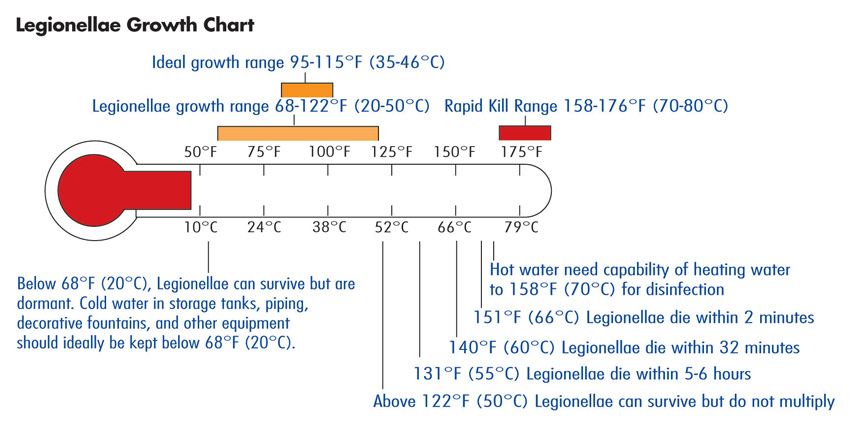
Legionella bacteria and other microorganisms can grow in the water in a building, particularly when the water temperature is favorable.
The American Society for Heating, Refrigeration, and Air-Conditioning Engineers (ASHRAE) has taken note of the connection between water-based mechanical and plumbing systems in buildings and legionella bacteria growth. It first published a guideline in the year 2000 titled Guideline 12-2000: Minimizing the Risk of Legionellosis Associated with Building Water Systems, which is commonly referred to as ASHRAE Guideline 12. Upon further review, it has also published the updated ANSI/ASHRAE Standard 188: Legionellosis: Risk Management for Building Water Systems, or ASHRAE 188. This publication has become the accepted standard for all types of facilities to address the control, monitoring, and treatment of legionella bacteria through a seven-step process to create and maintain an ongoing Water Management Program. Under such a program, design professionals are required to provide expertise on identifying and analyzing all aspects of the water systems. Then they need to recommend control measures and be involved with ongoing monitoring.
Protection Against Slips and Falls
As is the case in many facilities open to the public, slips and falls are the number one cause of accidents in hotels, restaurants, and public buildings according to the Bureau of Labor Statistics. This becomes particularly critical as the aging population in the United States is growing rapidly. The number of people age 65+ in 2010 (40.2 million) is projected to more than double by 2050. Slips and falls are due to a variety of conditions but are certainly exacerbated by the presence of water on a floor. That could be true in hospitality spaces, such as bathrooms open to guests or in behind-the-scenes places like commercial kitchens and laundries. In all of these locations, proper floor drainage becomes important so any spills, overflows, etc. can be addressed promptly. Sudden changes in shower water temperature (aka thermal shock) may cause a guest to slip and fall. Slips and falls can also take place outdoors, particularly in cold weather that creates icy walkway areas. In those cases, there is a need to incorporate a means to remove ice from at least the most active walking areas.
In light of all of the water demand and public safety items discussed above, we can now turn our attention to the types of water management solutions that can be considered as part of an overall design for hospitality facilities of all types and sizes.
Heating of Water
Providing hot water for guest and operational needs in a hotel or motel setting can be quite demanding and expensive if not designed and managed properly. Commonly, one or more central hot water heaters are employed that use natural gas or other energy sources so efficiency and high output become important. These water heaters are typically combined with pumps and piping to create a continuously recirculating system of hot water distribution. In that way, hot water is always available in the piping system, not just the water heaters, so there is little or no wait time when hot water is called for.
One of the biggest operational challenges of providing hot water is to assure that the demand can be met at all times. As noted already, hot water demand in guest rooms typically spikes in the early morning hours when people awake and shower and again late at night before people head to bed. That means the system needs to supply a lot of hot water during these peak times, but not so much in between. A popular approach to address this condition is to use high-efficiency, high-performance hot water heaters that are modular. In this way, multiple units can provide the maximum amount of hot water when needed, then step back to only one or two units when the demand decreases. Because these systems are typically compact and efficient, they can take up less floor space in mechanical rooms than older, traditional hot water boilers.
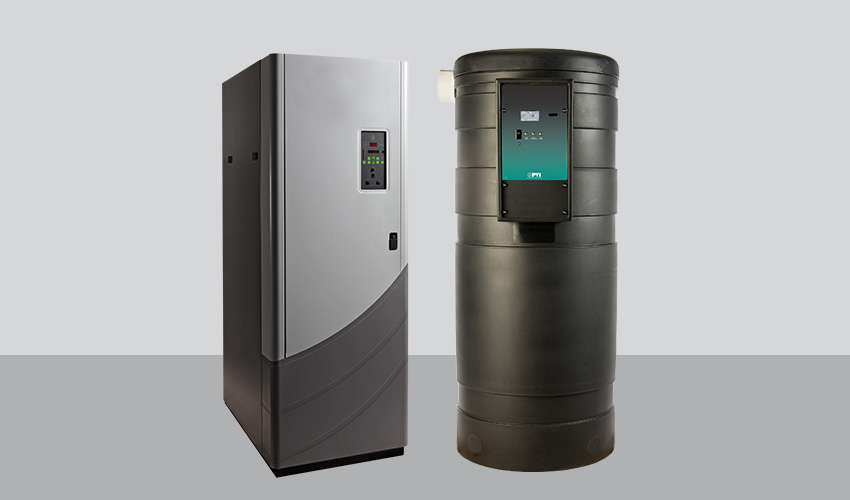
High-performance, efficient, modular water heaters can provide the needed amounts of hot water for a range of hospitality requirements.
Heating water is also commonly used to address legionella bacteria. The ideal range of temperature for the bacteria to grow is 95 to 115 degrees Fahrenheit, but the bacteria is known to grow and be active anywhere between 68 to 122 degrees Fahrenheit. The bacteria will die slowly when temperatures in the water reach 131 degrees Fahrenheit and rapidly between 158–176 degrees. At 124 degrees Fahrenheit, bacteria will not multiply. Based on this, Guideline 12 recommends hot water should be stored above 60 degrees Celsius (140 degrees Fahrenheit) and circulated with a minimum return temperature of 51 degrees Celsius (124 degrees Fahrenheit). It further suggests that in case of an outbreak being detected, a high-temperature flush of the system can occur to create a rapid kill of bacteria. Obviously for either of these conditions to happen, there needs to be proper control of the temperature of the water and the ability to produce these temperatures consistently.
Traditional Mixing and Tempering of Hot Water
Providing lots of hot water in a hospitality building is good for meeting demand and controlling legionella, but not good when it presents a scalding or burn potential. Therefore, the mixing of hot and cold water or “tempering” the temperature is an important design and operation consideration. This is why plumbing codes limit the maximum temperature exiting a fixture at 120 degrees Fahrenheit with the expectation that people can readily control the mix of cold and hot water at the faucet to meet their needs. However, there are plenty of things that can change the water temperature coming out of those showers and faucets. For example, pressure fluctuations can cause hot and cold water to move less predictably through the piping system, creating mixture imbalances at the point of use. Incorporating thermostatic mixing valves into the system is one way to help compensate for those discrepancies and deliver a more predictable and safer water temperature output.
When looking at mixing valve systems, there are two fundamental types. Both types are common and have a range of standards issued by the American Society of Sanitary Engineers (ASSE) relevant to their particular usage. A point-of-source (POS) system locates valves at or near the water-heating source, in the mechanical room (i.e., the tanks), and typically has a higher capacity for controlled temperature water. A point-of-use (POU) system uses multiple smaller mixing valves at or near plumbing fixtures, such as showers, lavatories, tubs, etc. POU systems are particularly useful to mitigate the risks of scalding when recirculating water at higher temperatures is employed throughout a building to control bacteria/legionella. In some cases, supplemental or separate, dedicated water heaters may be appropriate for laundry and kitchen areas if the demand for high-temperature water is significant enough. Either way, traditional mixing valves can be an appropriate method to temper and control water temperature, but the range of that control can vary quite a bit depending on the make and model of the valves installed.
Digital Mixing and Tempering of Hot Water
A more advanced approach to mixing water and controlling temperature more precisely is found in computerized digital mixing systems. In this type of system, digital control modules paired with fast-response sensors, and electronically actuated valves are used to allow faster and more accurate response to constant changes in the mixed water delivery demands, often anticipating system changes before they occur. As a point-of-source system, a digital mixing and recirculation station can provide precise control of hot water delivery within 2 degrees Fahrenheit of the set point, surpassing industry standards for mechanical systems. Further, it eliminates temperature creep within the system, thus eliminating the need for balancing valves. All of this means that it can more precisely be controlled to safely and efficiently provide the needed amount of hot water to hospitality guests and staff.
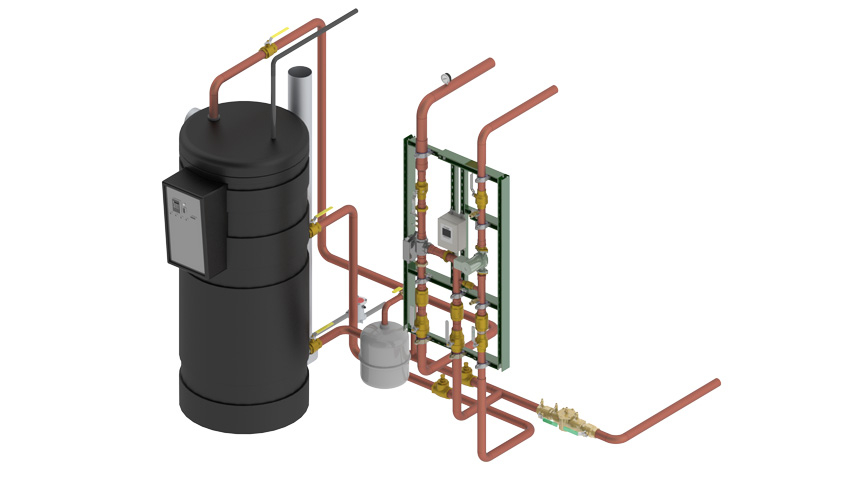
Digital mixing systems have the capability to deliver mixed hot and cold water throughout a facility within 2 Fahrenheit degrees of a controlled temperature.
Digital mixing and recirculating systems can also be used to mitigate legionella bacteria growth in the heated water. In particular, a sanitization or disinfectant mode can be triggered to raise the temperature above 158 degrees Fahrenheit to induce a “rapid kill” and purge all legionella bacteria. Passcode protected, facilities preselect the exact temperature and time duration for each purge. Concurrently, the digital system can control the circulation pump to prevent stagnant conditions or maximize flow rates. Finally, since most large facilities use some type of building automation system, a digital mixing system can be linked to the larger system to communicate and control temperature, pressure, flow, and energy consumption as part of an overall operations and maintenance plan. It also makes documentation and verification more straightforward in a water management program as called for in ASHRAE 188. From a specification standpoint, most of these systems are easy to install since they typically come pre-piped, pre-wired, and tested, allowing them to carry a warranty from the manufacturer for up to five years.
Water Quality and Conditioning
We have already established the need and expectation of good quality water in hospitality facilities so let’s look at some ways to achieve that. Fundamentally, there are two approaches, namely filtration and treatment, and both may be needed in any given facility.
Water Filtration
Water that arrives at a facility can contain a wide range of particulate matter, such as suspended particles, bacteria, viruses, gases, and others contaminants. The primary purpose of a filter is to remove these contaminants from the water before it gets to the point of being consumed. For hospitality situations, that may be accomplished with a large, commercial water filtration system at the water point of entry so the entire water supply is filtered. Or it may be accomplished on a point-of-use basis for selected locations, such as food service and beverage stations. The most common technology in either case is to use a carbon and/or fibrous filter that traps the physical contaminants and removes them from the water stream. Such filters require regular changing and related maintenance, but they can be very effective at removing unwanted contaminants from drinking water.
For cases where salts or other dissolved ions are a particular concern in water, reverse-osmosis systems may be worth considering. Reverse osmosis (RO) is a technology that is used to remove a large majority of contaminants from water, including dissolved solids such as salts, by pushing the water under pressure through a semipermeable membrane. Osmosis is a natural process that would normally induce the passage of clean water into heavier, salty water. Reversing the process through the use of a pump and pressure means the ionized, contaminated water is processed by the membrane and made clean. In the membrane, pure water is allowed to pass through the membrane material and exit as purified permeate water. Dissolved mineral salts are not allowed to pass through the membrane and become a concentrated reject stream that is sent to drain. Commercial RO systems are available that can provide multiple stages (two to six) of membrane processing to achieve 99 percent or better removal, with production rates ranging from 40 to 100 gallons per minute. Typically, these units are designed for floor-mount installations as a point-of-entry system for the full water supply or a dedicated portion of it.

Water filtration and treatment systems are available to address a wide range of concerns in sizes to suit a wide range of demands.
Water Treatment
Beyond filtration, there are other common water-quality issues that need to be addressed in hospitality settings. One of the first is the relative “hardness” of the water. Hardness is caused when compounds such as calcium, magnesium, and a variety of other metals are present in water, which is an excellent solvent and readily dissolves minerals it comes in contact with. As water moves through soil and rock, it dissolves very small amounts of minerals and holds them in solution. Since there is no health concern over hard water, the United States Environmental Protection Agency (EPA) does not issue standards for water hardness for public water supplies. However, hard water requires more soap and synthetic detergents for laundry and washing, and contributes to scaling in boilers and other water using equipment and appliances.
Water softeners are a commonly available technology to counteract the effect of minerals causing hardness in water. Typically, they use salts that react with the minerals to neutralize their effects. The degree of hardness will impact the amount of salts needed to achieve softening. Hardness is commonly measured in grains (64.8 milligrams) of mineral (commonly calcium carbonate) per gallon of water. Soft water is classified as having 1.0 grains or less of hardness. Between 1.0 and 7.0 grains, water is considered slightly or moderately hard. Hard water is defined as anything above 7.0 grains, with anything over 10.5 grains considered very hard. Salts used in water-softening systems have rated capacities for addressing hardness based on the level and the number of gallons of water that pass through it. Hence, the salts need to be changed periodically as their capacity for effectiveness is reached.
Other systems are available that seek specifically to address the problem of scale formation on internal and external plumbing surfaces. Over time, the minerals in hard water can attach to the metallic surfaces of a water system and start to build up. The resulting scale often becomes encrusted on the internal moving parts of valves, piping, and other components, effecting their intended purpose and potentially causing safety failures. In a boiler or hot water tank, heating elements can become coated with scale, reducing system efficiency and safety. In pipes and other components, it can restrict water flow and create potential breeding grounds for bacteria. In kitchen and laundry appliances, it can cause discoloration or pass some of the minerals on to things being cleaned, causing staining or discoloration in the process. While conventional water-softening systems can be used to address this, an alternative is to use a system which employs a template-assisted crystallization (TAC) process to prevent scale formation. This technology eliminates the need for salt, takes up less square footage than a water-softening system, and is generally regarded as much more economical with similar results. Anti-scale and water-softening systems may be installed at the point of entry to a building to treat both hot and cold water, or can be located directly before a water heater, boiler, or other water-using device that requires protection from the ill effects of hard water.
A final type of water treatment involves disinfection of the water to kill bacteria. While heating the water is good for legionella bacteria control, it may not be adequate for others. Some methods of disinfection involve the use of chemicals such as chlorine or the introduction of specific metal ions (i.e., copper) to prevent bacteria from growing. A simpler and highly effective technique against microbiological contamination in water is the use of a centralized ultraviolet (UV) disinfection system. Such systems are attractive not only because they can be very effective at killing microorganisms, such as legionella bacteria, but also because they are fairly simple to use and operate. Connected to a power source, they produce the UV light that is projected onto the incoming water without the need for any chemicals to be handled or added to the water. For large systems, they can be completely enclosed for safety to prevent any accidental UV exposure to people. They also typically have sensors indicating their use and performance levels and can be specified to operate efficiently by only turning on when there is actual water flow in the supply line. For hospitality facilities that are processing a large amount of water, such UV systems can be an economical means of protection.
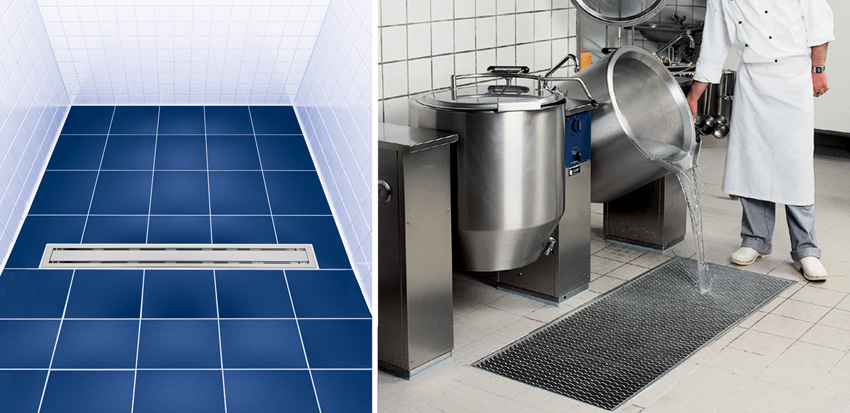
Stainless steel drainage products are more hygienic and longer lasting than alternative drainage products.
Drainage Systems
While much of what we have discussed so far is focused on the water supply, a significant portion of the water system in hospitality facilities is dedicated to water drainage. While most plumbing drainage systems follow some fairly standard design criteria, there are a few places that warrant some extra attention, particularly where hygiene is a priority. That could include things like bathroom and swimming pool showers as well as commercial kitchen drainage. In those cases, the use of stainless steel drains, fittings, and even piping have been shown to provide superior performance. Further, the nature of these stainless steel products often makes them quicker and easier to install than traditional materials.
For showers, standard, square, or round stainless steel drains can be incorporated into appropriately sloped floors. Increasingly, linear drains are popular, particularly for accessible or door-less showers such that the shower floor can be sloped in one direction toward the linear drain. In all of these cases, stainless steel provides superior performance, longevity, and low maintenance by being corrosion and chemical resistant. From a safety standpoint, they allow for shower floors that are flat and smooth to help protect against slips and falls. For hygiene, stainless steel is hard to beat since it provides an easy-to-clean surface that can lower bacteria growth and reduce the risk of infections.
In kitchens, stainless steel drains and piping provide similar benefits, particularly when linear trench drains are used under large cooking stations. In these cases, there are some particular characteristics to look for though. Gratings with open sides, rounded corners, and no cavities prevents waste and residue from depositing on the grating surface, thus providing easy and efficient floor cleaning. Infill of the frame and anchor tags improve hygiene and durability, minimizing the risk of frame distortion and flooring cracks maintaining a secure and durable bond to the floor. Channel geometry provides efficient water flow to the outlet area, keeping channels empty and clean, even during minimal water flow. Finally, rounded corners reduce the risk of joint deterioration and flooring cracks in resin flooring.
There are a few other ways that drainage systems can be considered in hospitality facilities. Rainwater harvesting can be undertaken using roof drainage piping connected to underground water storage tanks. The harvested rainwater can be used for landscaping or other non-potable needs. Greywater drainage from showers and kitchens can take advantage of the remaining heat in the water by running drain lines under outdoor walkways that are prone to ice and freezing, thus reducing the risk of outdoor slip-and-fall accidents. Other water diversion and reuse strategies like these can help reduce overall water demand, making the building more sustainable.
Backflow Prevention
Among the common elements in a water supply and drainage system, the use of backflow preventers is typical. Backflow systems are essentially a series of plumbing control valves that prevent the reverse flow of drainage water from entering into the potable water supply due to back-siphonage and/or backpressure. Some municipal water systems will require backflow systems, particularly on large water users such as hospitality facilities, since it is in the interest of public safety and health to do so. Therefore, including backflow preventers can be part of a control measure in a water management program in addition to a general best practice. Keep in mind that they don’t provide any treatment of the water, rather they simply help assure that the water is flowing in the proper direction to help maintain good water quality. When selecting backflow preventers, there are choices to consider. Stainless steel versions are available as basic or mid-tier products with some limited options. More robust and durable choices include ductile iron valves, some with epoxy-coated paint on the exterior, and designs for continuous or heavy usage.
Water System Design, Construction, and Operation
With an understanding of the range of water system-related issues in a hospitality project, there are several things to keep in mind when engaged in them. During design, information is needed on the water supply, its hardness, and any contaminant concerns. Similarly, the proper information on water demand in the facility is needed to correctly calculate the needs and size the water system equipment. This step is important because systems tend to be oversized, making them more costly and less efficient. This usually means engaging a consulting mechanical engineer well versed in these issues, but it can also mean partnering with a manufacturers technical team to understand the capabilities and limitations of available systems. Together, the focus should be on designing the right system for a facility, not just looking at individual pieces of equipment or components.
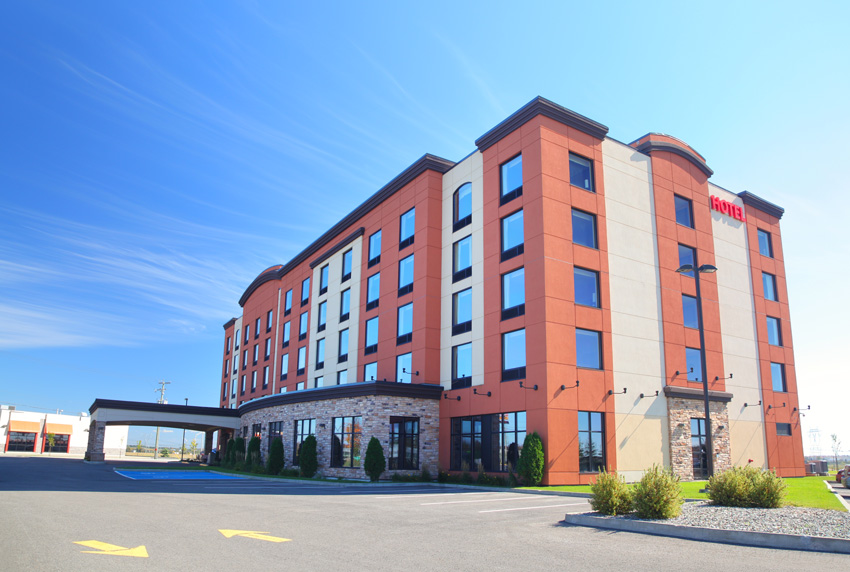
Taking a holistic approach to the design, construction, and operation of a complete water system solution for a hospitality facility reaps the best benefits for all involved.
Once the water system is installed, the owners and managers of hospitality buildings are appropriately concerned about smooth operations. Therefore, specifying a system where the suppliers are able to provide full and quick response to any issues that may come up can be seen as critical. Similarly, the ease of the system to be repaired and maintained with readily available personnel and replacement parts helps assure that system down time is avoided or minimized. A full warranty on all materials, equipment, and even labor will help assure an owner or maintenance staff that they have some assurance of smooth operations. In some cases, off site monitoring of the water system may be possible which, when tied with routine preventative maintenance, can help assure proper, safe, and efficient water operations for the life of the building.
Taking this holistic approach toward the design, construction, and operation of the water system produces multiple benefits for the facility owner and staff. First, optimal performance can be sought that assures the proper amount and temperature of water is provided when and where it is needed without wasting energy or water. Second, it achieves greater reliability so downtime can be minimized so guests aren’t inconvenienced or critical systems can’t function. These benefits lead to capital preservation for the owners through savings on operating expenses and full availability of income-generating guest rooms and other facilities. It can also help considerably with the management of the reputation of the property—problems with something as basic as water, safety, and comfort can drive guests away rather than appeal to them.
Conclusion
Hospitality facilities need well-designed, properly installed, and reliable plumbing systems to meet their needs for hot and cold water supply and drainage. There are clearly many choices available to create such systems that are high performing, safe, and efficient. Design professionals who can work together with specialists in this area can optimize the water solutions for specific hospitality facilities of all types and sizes.
Peter J. Arsenault, FAIA, NCARB, LEED AP, is a nationally known architect, sustainability consultant, technical writer, and continuing education presenter. www.pjaarch.com, www.linkedin.com/in/pjaarch

|
Watts is a global leader in the design and manufacture of innovative water solutions for residential, commercial, and institutional environments. Products include an extensive line of flow control, filtration, and treatment products for water quality and residential plumbing and heating. Founded in 1874, Watts is headquartered in North Andover, Massachusetts. www.watts.com |


